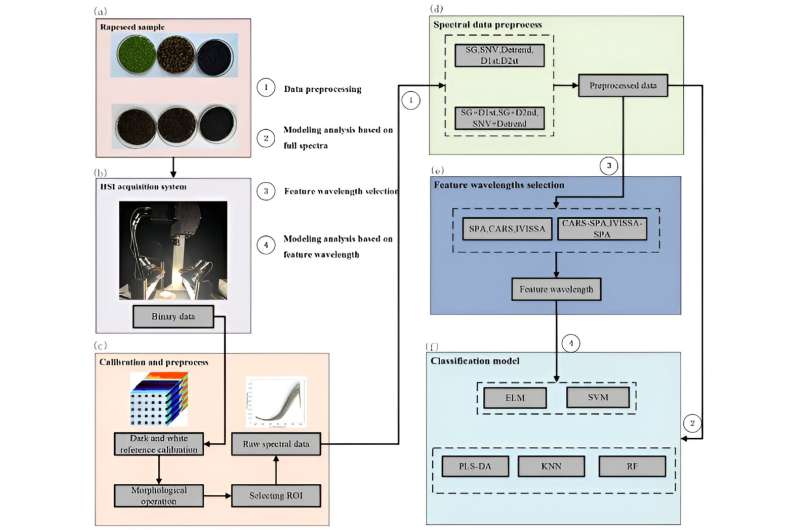This article has been reviewed according to Science X's editorial process and policies. Editors have highlighted the following attributes while ensuring the content's credibility:
fact-checked
trusted source
proofread
Enhancing rapeseed maturity classification with hyperspectral imaging and machine learning

Rapeseed oil, a vital oilseed crop facing growing global demand, encounters a significant challenge in achieving uniform seed maturity, owing to asynchronous flowering. Traditional maturity assessment methods are limited by their destructive nature. Hyperspectral imaging (HSI) offers a non-destructive, efficient solution by using spatial and spectral data to accurately classify crop maturity. This advancement in HSI technology presents an opportunity to enhance rapeseed quality and breeding research, addressing the need for more effective maturity classification methods.
In January 2024, Plant Phenomics published a research article titled "Maturity classification of rapeseed using hyperspectral image combined with machine learning."
In the study, HSI technology was employed to analyze the spectral characteristics and classify the maturity levels of rapeseed. The spectral data underwent various preprocessing methods, including Savitzky-Golay (SG) smoothing, Standard Normal Variate (SNV), Detrend, and derivatives (D1st, D2nd), to enhance the data quality by reducing noise and emphasizing the relevant spectral features for maturity classification.
The analysis revealed distinct spectral patterns across different maturity stages of rapeseed, particularly within the 420-982 nm wavelength range, where the fully mature stage showed increasing disparity from the green and yellow stages, especially beyond 720 nm.
The modeling analysis, utilizing the entire wavelength range, revealed notable discrepancies in accuracy and precision across various preprocessing methods and classification algorithms, including Extreme Learning Machine (ELM) and Support Vector Machine (SVM).
Models using preprocessed spectral data generally outperformed those using original data, with D2nd and combinations like SG+D1st achieving high prediction accuracies above 92%. Feature wavelength selection further refined the model by identifying key wavelengths that are crucial for maturity classification, with CARS and IVISSA-SPA algorithms extracting the most effective wavelengths for accurate maturity prediction.
Subsequent classification models based on selected feature wavelengths showcased superior performance, with D2nd-IVISSA-SPA-SVM achieving an impressive accuracy rate of 97.86%. This approach effectively addressed data redundancy and highlighted the importance of selecting optimal feature wavelengths for developing robust maturity classification models.
The study emphasizes the immense potential of integrating HSI technology, preprocessing methodologies, and machine learning algorithms for the non-destructive evaluation of rapeseed maturity. Such integration holds promise for driving future advancements in this domain.
More information: Hui Feng et al, Maturity classification of rapeseed using hyperspectral image combined with machine learning, Plant Phenomics (2024). DOI: 10.34133/plantphenomics.0139
Provided by NanJing Agricultural University





















